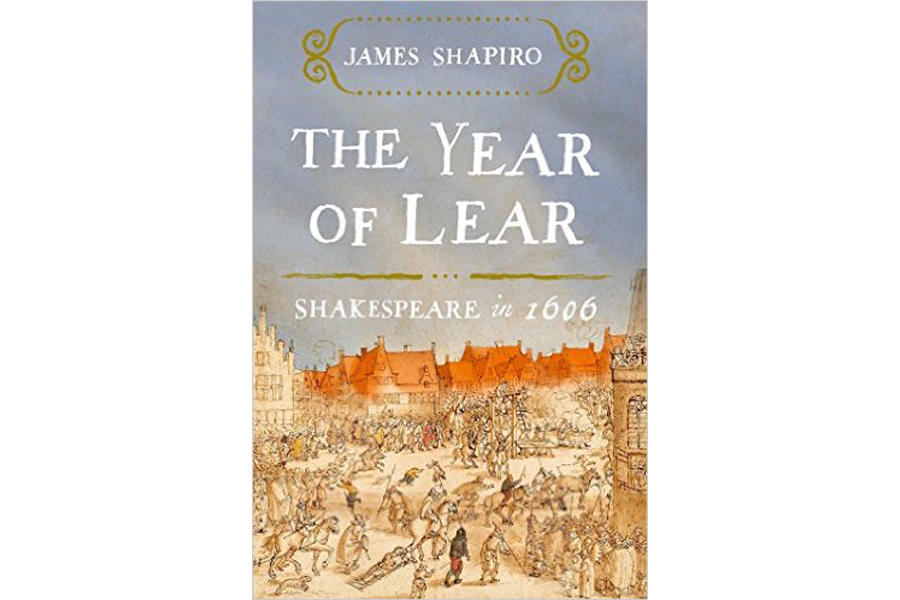'The Year of Lear' skillfully traces the mark of current events on Shakespeare
Loading...
William Shakespeare’s most famous works are something like a chain of islands in an evaporating sea. The plays were originally submerged in a distinct cultural moment, awash in contemporary politics, scandals, and topical allusions. The prominence of these once-current events has receded over the past 400 years. But traces of their vanished influences are still visible in the plays themselves, smoothed and shaped by the liquid ambience of the times.
James Shapiro’s insightful new book, The Year of Lear: Shakespeare in 1606, performs a kind of archaeological excavation of the three plays Shakespeare wrote in this year – "King Lear," "Macbeth," and "Antony and Cleopatra" – to reveal the rich matrix of factors that molded their themes and language.
After a lull in his writing between 1603 and 1606, Shakespeare experienced an extraordinary burst of creative energy. “The year 1606 would turn out to be a good one for Shakespeare and an awful one for England,” Shapiro writes. Religious factionalism was convulsing England in the early 17th century, and a group of Catholic conspirators had almost succeeded in blowing up Parliament and murdering King James in 1605. A shaken James did his best to use what became known as the Gunpowder Plot to push his own political agenda, which centered on establishing a formal political union between England and Scotland.
The Catholic plotters were quite literally demonized: Much public discourse presented their scheme as an evil symptom of demonic possession. An outbreak of the plague in London also made many people wonder if the sickness was sent by God to cleanse the city of sin. It’s probably not coincidental that Shakespeare’s plays during this year deal with the consequences of a divided kingdom, the death of a Scottish monarch, and the nature and origin of evil. As Shapiro capably demonstrates, this tumultuous moment in English history inspired Shakespeare in many important ways.
In a passage from his book on the Gunpowder Plot, King James described the conspirators as “the rarest sort of monsters,” a phrase that Shakespeare echoes when Macduff classes Macbeth among “our rarer monsters.” Shakespeare found a deeper lexical mine in a book by Samuel Harsnett called "Declaration of Egregious Popish Impostures." This volume cataloged and exposed cases of feigned demonic possession in which young women faked symptoms of madness so that Catholic priests could appear to perform miraculous exorcisms. More than 80 passages in "King Lear" show evident borrowings from this source: everything from the names of particular devils to the eerie image of a blade floating in the air.
Shakespeare also registered the charged religious atmosphere of 1606 in many subtler ways. One contemporary treatise by a Jesuit priest instructed Catholics in the art of “equivocation,” which was essentially the practice of lying and deceit in certain circumstances. If a Catholic hid a priest in his home, the treatise argued, it was morally defensible to use deliberately ambiguous words to mislead the Protestant authorities searching for him. One could say, for example, that the priest “lyeth not in my house,” since he was telling no lies in the house, even though he might be lying hidden in a basement.
Before the Gunpowder Plot, the word “equivocation” was not synonymous with dissembling. After the trial and execution of the priest who wrote this treatise, however, the word was tarnished and redefined. Deceit and deception are themes in many of Shakespeare’s plays, but "Macbeth" is a particularly unsettling study of misleading language and its political implications. When Macduff has yet to learn that his wife and children are dead, he asks Ross about their fate: “The tyrant has not battered at their peace?” Ross knows that Macduff’s entire family has been killed, but he gives a chilling reply that leaves the meaning of “peace” equivocal: “No; they were well at peace when I did leave ‘em.”
A skilled equivocator himself, Macbeth is ultimately destroyed by the veiled meanings lurking inside the prophecies of the apparitions the Sisters summon. They tell him that “none of woman born/ Shall harm Macbeth,” and promise that he will never be defeated until “Great Birnam Wood” itself approaches. By the end of the play, Macbeth has grasped the hidden sense coiled in these lines. Macduff’s mother had a caesarean section, so in a way he was not born “of woman.” And as an army of soldiers approaches Macbeth bearing branches cut from this Birnam wood, Macbeth realizes that the trees are indeed approaching him. He laments the “equivocation of the fiend/ That lies like truth.”
Macbeth may blame his downfall on supernatural forces, but the play suggests that features of human nature are sufficient to explain murder and betrayal. This was a radical and relevant insight at a time when many Londoners believed that demons and devils were responsible for the recent attempt on King James’ life.
Shapiro is equally adept at illuminating the ways in which "King Lear" and "Antony and Cleopatra" are entangled with the political and religious currents of their times. Harold Bloom, probably the loudest if not always the most insightful of Shakespeare idolaters, has dismissed the sort of historically contextualized readings of the plays that Shapiro offers.
“Wisdom finally cannot be the product of social energies, whatever those are. Cognitive power and understanding heart are individual endowments,” Bloom once wrote. This is true to a point, but characteristically overstated. Shapiro shows precisely what social and cultural energies are and how they influence even – perhaps especially – the most extraordinary minds and hearts.






